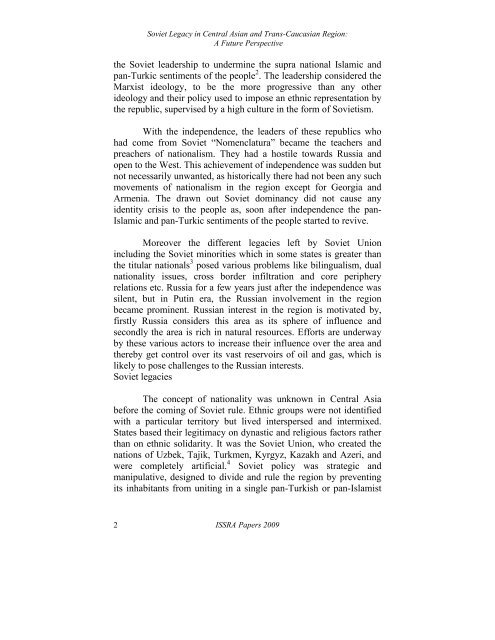issra papers vol i, 2009 - National Defence University
issra papers vol i, 2009 - National Defence University
issra papers vol i, 2009 - National Defence University
Create successful ePaper yourself
Turn your PDF publications into a flip-book with our unique Google optimized e-Paper software.
Soviet Legacy in Central Asian and Trans-Caucasian Region:<br />
A Future Perspective<br />
the Soviet leadership to undermine the supra national Islamic and<br />
pan-Turkic sentiments of the people 2 . The leadership considered the<br />
Marxist ideology, to be the more progressive than any other<br />
ideology and their policy used to impose an ethnic representation by<br />
the republic, supervised by a high culture in the form of Sovietism.<br />
With the independence, the leaders of these republics who<br />
had come from Soviet “Nomenclatura” became the teachers and<br />
preachers of nationalism. They had a hostile towards Russia and<br />
open to the West. This achievement of independence was sudden but<br />
not necessarily unwanted, as historically there had not been any such<br />
movements of nationalism in the region except for Georgia and<br />
Armenia. The drawn out Soviet dominancy did not cause any<br />
identity crisis to the people as, soon after independence the pan-<br />
Islamic and pan-Turkic sentiments of the people started to revive.<br />
Moreover the different legacies left by Soviet Union<br />
including the Soviet minorities which in some states is greater than<br />
the titular nationals 3 posed various problems like bilingualism, dual<br />
nationality issues, cross border infiltration and core periphery<br />
relations etc. Russia for a few years just after the independence was<br />
silent, but in Putin era, the Russian in<strong>vol</strong>vement in the region<br />
became prominent. Russian interest in the region is motivated by,<br />
firstly Russia considers this area as its sphere of influence and<br />
secondly the area is rich in natural resources. Efforts are underway<br />
by these various actors to increase their influence over the area and<br />
thereby get control over its vast reservoirs of oil and gas, which is<br />
likely to pose challenges to the Russian interests.<br />
Soviet legacies<br />
The concept of nationality was unknown in Central Asia<br />
before the coming of Soviet rule. Ethnic groups were not identified<br />
with a particular territory but lived interspersed and intermixed.<br />
States based their legitimacy on dynastic and religious factors rather<br />
than on ethnic solidarity. It was the Soviet Union, who created the<br />
nations of Uzbek, Tajik, Turkmen, Kyrgyz, Kazakh and Azeri, and<br />
were completely artificial. 4 Soviet policy was strategic and<br />
manipulative, designed to divide and rule the region by preventing<br />
its inhabitants from uniting in a single pan-Turkish or pan-Islamist<br />
2<br />
ISSRA Papers <strong>2009</strong>

















